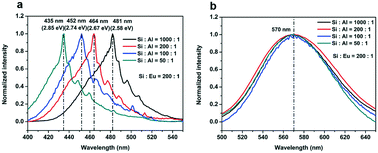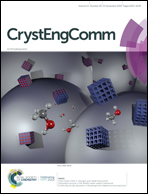Bandgap trimming and optical properties of Si3N4:Al microbelt phosphors for warm white light-emitting diodes†
Abstract
Si3N4:Al microbelts with tunable bandgap energy and resultant yellow-orange phosphors are prepared through a facile direct nitridation method. The bandgap energy of Si3N4:Al microbelts has been gradually trimmed from 2.58 eV to 2.67, 2.74 and 2.85 eV by regulating the Si/Al molar ratio from 1000 : 1 to 50 : 1. Si3N4:Al:Eu phosphors display a wide emission ranging from 500 to 800 nm when excited by a 450 nm blue LED light source. The crystal structure of Si3N4:Al microbelts is of the α-Si3N4 phase as characterized by X-ray diffraction, high-resolution TEM and crystal models. Si3N4:Al microbelts grow along the (012) stacking direction in a low doping concentration case and grow along the (011) stacking direction in a high doping concentration case. Theoretical calculation results show that Al prefers to occupy the low energy interstitial sites in the (012) plane. There are more substitutional sites in the (011) plane occupied by Al in the high doping concentration case with increasing the bandgap energy of Si3N4:Al. Warm white light emission has been achieved by precoating Si3N4:Al:Eu phosphors onto a blue LED chip, whose correlated color temperature (CCT) can be tailored from 3000 K to 6500 K by altering the phosphor amount, indicating a promising potential application of Si3N4:Al:Eu phosphors in warm white LEDs.



 Please wait while we load your content...
Please wait while we load your content...